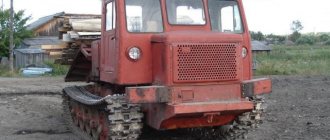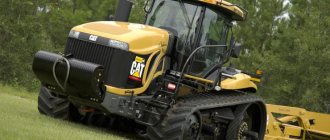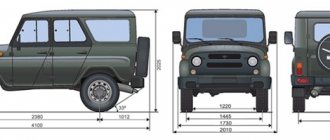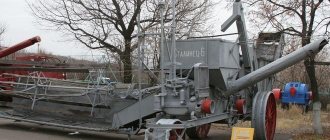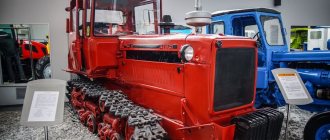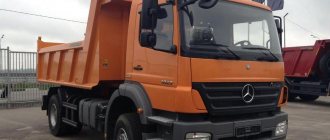Tractor "KD-35"
0
Source:
See all photos in the gallery
November 4, 1950 was noted in the chronicle of the labor exploits of Belarusian tractor builders as the day the serial production of KD-35 tractors began. The first-born of Minsk tractor builders enjoyed great and well-deserved success among field workers. The KD-35 tractors were equipped with 4-cylinder diesel engines producing 37 hp. the engine was distinguished by significant efficiency. Thus, for one hectare of plowing under average conditions, it consumed 13 kg of fuel. The tractor's fuel tank contained fuel for 10 hours of uninterrupted operation. Prototypes of the machine plowed up to 6 hectares of land in 10 hours. The tractor was not produced by the plant for long, only 9 months, until August 1951. During this time, 406 cars rolled off the assembly line. The production of diesel and starting engines for the KD-35 at the plant did not stop. They were supplied to the Lipetsk Tractor Plant. Subsequently, this engine was used on a wheeled universal row-crop tractor, on which factory designers had been working since 1948.
MTZ-1 and MTZ-2
0
Source:
The Belarus universal wheeled tractor was designed to work with mounted, semi-mounted and trailed agricultural machines. The design of the tractor was made in two modifications: MTZ-2 - for inter-row cultivation of low-stem crops with matching tracks of the front and rear wheels and MTZ-1 - for processing high-stem crops with close front wheels. The tractor was designed to operate on two wheels: low-pressure rubber cylinders and wheels with a rigid steel rim with spurs. The tractor had an independent power take-off shaft drive, a hydraulic system for lifting mounted implements, and was equipped with a removable adjustable tow hitch. July 18, 1949 became a significant day for all tractor manufacturers. The first Belarusian factory-designed wheeled tractor emerged from the gates of the experimental workshop. A prototype of a wheeled tractor subsequently became the basis for the creation of the MTZ-2 serial machine. In 1949, 7 prototypes were produced and underwent lengthy factory tests. A historical date for the plant’s staff was 1953, when on October 14, the assembly of the MTZ-1 and MTZ-2 tractors, created by the plant’s designers, was completed on the main conveyor. These machines determined the entire further specialization of the plant in the production of wheeled universal row-crop tractors.
×
0
Source:
Technical characteristics of MTZ 82
| Overall length (at ends of longitudinal rods) | 3,930 mm |
| Overall width (at the protruding ends of the rear wheel axle shafts) | 1,970 mm |
| Height along cladding | 1,665 mm |
| Cabin height | 2,470 mm |
| Longitudinal base | 2 450 mm |
| Front wheel track | 1 300-1 800 mm |
| Wheels on the rear wheels | 1 350-2 100 mm |
| Maximum power | 80 kW |
| Rotation frequency | 2,200 rpm |
| Number of cylinders | 4 |
| Cylinder diameter | 110 mm |
| Piston stroke | 125 mm |
| Cylinder displacement | 4.75 l |
| Cylinder operating order | 1-3-4-2 |
| Steering, pump supply | 21 l/min |
| Hydraulic system, pump supply | 45 l/min |
| Hydraulic system pressure | 16 MPa |
| Nominal voltage in the electrical system | 12 V |
MTZ 82 videos
KT-12 and KT-12A
0
Source:
In the spring of 1951, the MTZ team received a very important government task - to master the production of skidders, which were in great demand in the logging industry. The KT-12 gas generator tractor is a special tracked vehicle designed for forest skidding. It appeared in the USSR in the first post-war years. There were no analogues to it in any country in the world. Previously, skidding was carried out by horse-drawn vehicles, manual or mechanical winches. The KT-12 tractor was created by designers of the Kirov plant in Leningrad in collaboration with scientists from the Leningrad Forestry Academy. The KT-12 tractor was produced at the Kirov plant until 1951. Now it was necessary to establish its production at the Minsk Tractor Plant. Only three months were allotted to resolve all organizational issues. So, in the short history of its existence, MTZ had to develop a second (after the KD-35) machine, and, moreover, not of its own design. On August 15, 1951, the first batch of KT-12 skidding machines rolled off the main conveyor of the tractor assembly shop. During the production process, the tractor underwent modernization aimed at improving the performance of the machine. In a short period of time, factory designers, by changing a number of components and parts, increased the warranty period of the machine by 1.5 times.
Large cab spare parts catalog
A unified large cabin began to be installed on tractors in 1980 and is used to complete modifications of this model with minor modifications to this day.
Considering the versatility of the tractor and its wide use with various traction and drive devices, the high driver’s seating position and the maximally increased glass area provide the driver with a wide overview to control the movement and operation of the MTZ 82 as part of the units. The increased internal volume of the cabin provides additional operating comfort for the driver.
Large Cabin Assembly Parts
Parts List
Parts List
Parts List
The interior doors open against the direction of travel, which provides a convenient process for driver entry and comfortable access to the vehicle interior during servicing.
Large cabin MTZ 82.1
Thanks to the included components: vibration isolators for fastening the frame to the frame of the machine; rubber seals and an original cross-section profile in openings, opening windows, doors and hatches - the large interior is distinguished by increased noise, dust and vibration insulation performance, which has a positive effect on the level of comfort and microclimate.
TDT-40
0
Source:
In the early 50s, the USSR Ministry of Forestry Industry stated that the KT-12A with its gas generator installation did not meet the increased requirements. Considering the disadvantages of the tractor, the ministry decided to abandon this machine altogether and raised the question of creating a new, more reliable skidder with a power of 60 hp instead. Having analyzed the situation, the designers and management of MTZ recognized the feasibility of creating a more powerful skidder, but also expressed the opinion that one powerful class of tractor for all zones in all forestry operations would be uneconomical. It was necessary to design a medium-power skidder that could be created on the basis of the KT-12A by installing a diesel engine of a Belarus wheeled tractor on it. In 1954, they developed the design of such a tractor, giving it the brand TDT-40. The tractor was intended for transporting logs directly from the cutting area. In addition to timber skidding, it was indispensable in logging and in all kinds of transport work in off-road conditions. Based on the results of operational tests in 1955, the interdepartmental commission stated that the TDT-40 tractor was very necessary for the USSR Ministry of Forestry Industry and it was advisable to establish its production in a short time. By decision of the USSR Ministry of Tractor and Agricultural Engineering, serial production of TDT-40 diesel tractors began at MTZ in May 1956. By the end of the year, their number reached 3,430. In the same year, design work was completed and the first experimental D-50 diesel engines for the promising tractor were manufactured. The new engine exceeded the power of its predecessor by 10 hp, was smaller in size and 350 kg lighter.
Units and systems Belarus 82
Engine
The first tractors produced were equipped with a D 240 diesel engine. But if the power of this engine is 78.0 hp. With. acceptable for the Belarus 80 model, it was not enough for the all-wheel drive version.
Therefore, in the mid-eighties, the MTZ 82 began to be equipped with a new in-line, four-cylinder power unit D 243 with modified technical characteristics.
It had a power of 81.0 hp. pp., economical operating mode and lighter weight. The base fuel consumption was 230 g/(kW h).
Table No. 1. Fuel consumption in operating modes
| Operating mode | Unit | Consumption |
| Transport | 1 engine hour | 7.0 l/h |
| Plowing (middle soil group) | 1 ha | 33.6 kg/ha |
| Sowing (middle soil group) | 1 ha | 14.9 kg/ha |
| Cultivation (middle soil group) | 1 ha | 9.5 kg/ha |
| Plowing firebreaks | 1 km | 210 kg (per 100 km) |
| Crop processing | 1 ha | 5.6 kg/ha |
These indicators confirm the economical use of the tractor. The motor is also characterized by low oil consumption.
To do this, use the engine oil recommended by the manufacturer, and also monitor and perform timely replacement of the oil and oil filter, monitor the serviceability of the pressure sensor, since untimely replacement or lack of oil leads to breakdown of the D 243.
The oil volume in the engine device is 12 cubic meters. dm (weight 11.2 kg), and the shift frequency is 250 hours.
To maintain an economical operating mode, as well as a long, reliable engine life, it is necessary to perform timely valve adjustments on the power unit.
The frequency of valve adjustment on the tractor is 480 operating hours. Moreover, thanks to the repairable design of the diesel engine, the machine operator performs such adjustments manually.
When adjusting the valves, the order corresponds to the operation pattern of the cylinders, and in correctly adjusted valves on the MTZ 82, the gap does not exceed 0.25 mm.
An electric starter is used to start the engine. Moreover, despite the characteristics and power of the engine, it is characterized by difficulties when starting in the cold season.
To facilitate such starting, an engine preheater is used. Modern manufactured versions of Belarusian tractors have a special connector in the internal combustion engine cylinder block for connecting such a heater.
It has a power of 1.8 watts, operates from a 220-volt network, and heats the engine coolant to 50-60 degrees in 20-25 minutes.
Cabin
Initially, Belarus 82 was equipped with a small cabin. The initial use of the small cabin helped to quickly master the production of the tractor. Relative advantages are:
- simplicity of design;
- light weight;
- small dimensions.
This made it easy to remove the cabin and carry out the necessary repairs in rural workshops. Such a cabin had many more disadvantages. It did not provide comfortable working conditions for the operator:
- lack of cladding, resulting in low noise insulation and poor dust protection;
- insufficient glass dimensions and the height of the rear window did not allow for a high-quality view;
- lack of a standard heater;
- poor quality of the electrical circuit of the instrument panel.
In the mid-eighties, the plant began producing MTZ 82 with a larger cabin. But until this time, machine operators independently, by hand, made changes to the design. These works (tuning) were carried out according to pictures and diagrams of already modified cabins.
Such operations include:
- installation of a homemade heater;
- installation of felt sheathing;
- use of enlarged side mirrors;
- installing a homemade rear window wiper.
The tuning of the old cabin, carried out independently, introduced local changes to the working conditions of machine operators, so the release of a new modification with a large cabin increased comfort, and as a result, the productivity of machine operators.
Transmission and steering Belarus 82
To perform agricultural work and other operations, in addition to a reliable and economical engine, the MTZ 82 has a mechanical transmission. The composition includes the following elements and components:
- clutch;
- manual transmission;
- transfer case;
- hydraulic speed reducer;
- rear all-wheel drive axle with final drives and differential;
- front drive axle with final drives, self-locking differential,
- rear PTO.
Features of the transmission include the use of a hydraulic version as a creeper, not a mechanical version, as on the Belarus 80. The operating principle of the device is to use a special hydraulic motor and a regulator with a safety valve, which carry out a given rotation of the shaft of the required manual transmission transmission.
The main advantages are all-wheel drive and increased cross-country ability, which also depends on the size of the wheels used. The standard front wheel tire size is 11.2 – 20, where;
- 11.2 - profile width;
- 20 — front disc mounting diameter (in inches).
The standard rear wheel size is 15.5R38. Sometimes, depending on the specialization or use of the tractor, for example, for processing melons, wheels may be 9.5-42, while the front wheels are also changed to narrow ones.
The all-wheel drive used requires a lot of effort on the steering wheel, despite the use of power steering.
Therefore, the steering control of the old MTZ 82 model was often independently modified by machine operators to install a special dispenser with a pump.
This connection scheme reduced the effort on the steering wheel, simplified maintenance, and increased the service life of the steering system.
In addition, the redesigned MTZ 82 steering device from power steering to a dispenser reduced the possibility of malfunctions.
During the conversion work, a special kit for the steering meter was used.
Hydraulic system
A hydraulic system is required to connect specialized equipment to Belarus 82.1 MTZ. The main mechanisms are:
- hydraulic pump;
- distributor;
- hydraulic cylinders;
- hydraulic booster;
- hydraulic accumulator;
- power regulator;
- pipelines, fittings, hydraulic filter;
- hydraulic oil tank.
One of the important elements of the hydraulic system is the pump, which creates the necessary flow of working fluid in the system. The MTZ 82 is equipped with an NSh 32 pump; it provides a capacity of 45 liters of oil per minute, driven by a special wool rear power take-off shaft.
For reliable operation, use hydraulic oil recommended by the manufacturer, and also replace the hydraulic filter in a timely manner.
TDT-54 and TDT -60
0
Source:
To work in the forests of the Urals, Siberia and the Far East, more powerful skidders were required than the TDT-40. The Ministry of Automotive Industry instructed the designers of the Minsk Tractor Plant to develop a project for such a tractor in conjunction with the Scientific Research Autotractor Institute (NATI) according to the technical requirements of the Ministry of Forestry Industry of the USSR. Initially, the tractor was given the brand TDT-54. To increase productivity, a D-54 diesel engine with a power of 54 hp was used. tractor DT-54 of the Kharkov Tractor Plant. After the skidder TDT-54 received the go-ahead from the state commission for mass production, a detailed analysis of each unit was carried out. As a result, it was decided to modernize most of its components. In addition, the D-54 diesel engine was boosted to 60 hp. and as a result, the tractor received a new name TDT-60. In 1956, four of its prototypes passed all control state tests under production conditions at the Vakhtansky timber industry enterprise in the Gorky region. The simultaneous production of two tractors, MTZ-2 and TDT-40, completely different in design and purpose, put the plant in a difficult position. The plant did not have the opportunity to simultaneously develop two different productions: the production of the MTZ-2 tractor, which was extremely necessary for agriculture, and the TDT-40 tractor, in which the USSR Ministry of Forestry Industry was interested. Technical and economic calculations showed that the Minsk Plant needs to specialize in the production of wheeled universal row-crop agricultural tractors. The management of the plant submitted a proposal to the ministry - to stop production of the TDT-40 tractor at MTZ, transferring it to the plant in Karelia, and the developed TDT-60 model to the Altai Tractor Plant. By decree of the USSR government of January 30, 1956, the Onega Machine-Building Plant in Petrozavodsk was transferred to the Ministry of Tractor and Agricultural Engineering of the USSR for the production of TDT-40 tractors. Before that, it was under the jurisdiction of the USSR Ministry of Forestry Industry. In 1957, without stopping the production of TDT-40 at MTZ, the development of the tractor began at the Onega Tractor Plant. In total, until 1958, MTZ produced 12,977 TDT-40 tractors. In 1957, the TDT-60 tractor was put into serial production at the Altai Tractor Plant. This was the end of the history of skidders at MTZ, where for 7 years they were produced in parallel with wheeled ones.
MTZ-5
0
Source:
Time passed, and with it the requirements for the manufactured MTZ-2 tractor grew. It had a low transport speed (13 km/h) and an insufficient number of gears. The tractor began to lag behind in terms of fuel efficiency and material consumption. It was necessary to increase the reliability and service life of the machine. Having summarized the experience of operating MTZ-2 tractors, taking into account the state and level of tractor manufacturing, the plant’s design team in 1955-1956. carried out work on a radical modernization of the machine. This made it possible not only to eliminate existing shortcomings, but also to expand the scope of application of the machine and improve technical and economic indicators. This is how new models of the Belarus tractor appeared: MTZ-5 (1956 model). MTZ-5M and MTZ-5L (samples of 1957). MTZ-5, possessing great versatility, had an independent power take-off shaft drive, a more powerful and economical engine, and a hydraulic linkage system with remote cylinders.
Versatile low profile cab
In the factory version, tractors with low-profile cabs in this traction class are produced under the brand MTZ 921 and MTZ 922. For MTZ 82, low-profile cabs are produced only by a number of private enterprises in Belarus, Poland and Russia. The unit has a frame base similar to the unified cabin. The reduced height profile allows the tractor to be used in cultivating garden plantings, carrying out work in livestock sheds and other premises with low entrance openings. When installing this unit, the height dimensions of the tractor correspond to 2650 mm.
Low profile cab
Comparison of low profile and standard cabs
MTZ-5S
0
Source:
In 1959, after design improvements, production of the MTZ-5LS and MTZ-5MS tractors began. The letter “C” in the designation meant “high-speed”. Engine power was increased to 48 hp. (instead of 45) by increasing the speed to 1600 rpm (instead of 1500). The operating speed range was set within 5-10 km/h. The number of working gears in the gearbox was increased from four to five. Otherwise, there were no fundamental differences from the MTZ-5L and MTZ-5M tractors. Production of high-speed cars began in 1959.
MTZ-7
0
Source:
In 1958, the design was finalized, prototypes were made, tests were carried out, and drawings for the MTZ-7 all-terrain tractor with four driving wheels were issued in preparation for production. The first tractor design was developed using the front drive axle from the military all-terrain vehicle GAZ-67, did not have an adjustable track width of the front wheels and therefore did not provide for row-crop work. Due to the insufficient strength of the GAZ-67 bridge, the tractor did not pass the tests. The problem was solved after a GAZ-63 drive axle was installed on the tractor. The production of cabins for Belarus tractors began. The design of the removable cabin made it possible to use it on the tractor completely closed and in the form of an awning. With the use of such a cabin, the working conditions of the tractor driver have significantly improved.
Advantages and disadvantages
The versatility of the MTZ-82 attracts farmers not only from Belarus, but also from other CIS countries. In addition to its advantages, the tractor also has disadvantages.
| Advantages | Flaws |
| Good transmission. Allows the tractor to move steadily at lower speeds | Requires effort on the steering wheel |
| New gear reducer. This allows you to increase the speed range, with a minimum of only 1.2 km/h | Constant replacement of wearing elements is required until they completely fail |
| High tire pressure allows you to increase speed on asphalt roads | It is not always possible to find the necessary spare parts at affordable prices from the manufacturer |
| The driver of the transport device can independently adjust the power take-off shaft | Comfort in the driver's cabin is low, there are no conditions for long-term work in the field |
| Compared to its predecessor, the MTZ-82 has a new hydraulic attachment system with a hydraulic booster, which allows it to increase the load capacity | Doesn't start well in cold weather |
| High maneuverability of the tractor thanks to the front drive axle |
Fact!
The gearbox has two modes: low for work and high for movement and transportation.
MTZ-50
0
Source:
Until 1959, MTZ had the capacity to produce only 18,000 wheeled tractors of the MTZ-2 type, 6,000 TDT-40 tracked skidders and 40,000 D-40 engines. Serial production of the MTZ-5, MTZ-5M, MTZ-5L tractors was still underway, work was carried out to modernize them, and in 1956 the designers basically designed a new diesel engine for the future MTZ-50 tractor. There was great interest in the creation of a new promising row-crop tractor not only at the plant, but also in the country. The technical design of the tractor was completed in 1957 and approved by the Main Scientific Automotive and Tractor Institute. In 1958, the experimental workshop produced several prototypes of the tractor. Based on the test results, the scientific and technical council of the VO "Soyuzselkhoztekhnika" recommended the wheeled universal row-crop tractor class 1.4 "Belarus" MTZ-50 for mass production. The MTZ-50 tractor was equipped with a 55 hp diesel engine, the weight of the machine was reduced by more than 400 kg. The tractor transmission was equipped with a 9-speed gearbox, providing a speed range ranging from 1.65 to 25 km/h.
MTZ-52
0
Source:
In 1959, based on the results of state tests, the design of the MTZ-50 tractor was finalized, the necessary documentation was issued and put into preparation for production. Based on the MTZ-50 tractor, a modification of the all-terrain tractor with four driving wheels, the MTZ-52, was developed. Due to lower slipping losses, the fuel efficiency of the MTZ-52 tractor is higher at all operating limits than the MTZ-50 tractor. On November 14, 1959, the Council of Ministers of the USSR issued a resolution “On the organization of specialized production of wheeled tractors, motorcycles and engines for them at enterprises of the BSSR.” One of the points of the document stated: 2. Oblige the Council of Ministers of the BSSR to ensure: c) the production of Belarus MTZ-50 tractors starting in 1961 and MTZ-52 tractors starting in 1962, increasing the production of tractors of these brands to 75,000 units in 1965 year. The Council of the National Economy of the BSSR, by its decision of December 19, 1961, decided: 3. For a non-stop transition to a new tractor model, provide for the phased introduction of the MTZ-50 tractor, for which: - approve the transition model MTZ-50 tractor for production at MTZ for 1961-1962 PL on the chassis of the MTZ-50 tractor with a serial D-48 PL engine, boosted to 50 hp. - production of MTZ-50 tractors with the D-50 engine will begin in the fourth quarter of 1962. 1960 The plant is under reconstruction. New equipment was installed in the workshops and outdated equipment was replaced. The design of the MTZ-50 tractor was finalized, the necessary documentation was issued and put into preparation for production. Based on the MTZ-50 tractor, the plant's design team developed a modification of the high-cross-country tractor with four driving wheels MTZ-52. This machine complemented the basic model and expanded its scope of application in agricultural and transport work, especially in conditions of high soil moisture.
MTZ-50X
0
Source:
In 1963, the design development was completed and prototypes of the MTZ-50 cotton-growing tractor were produced. The tractor is designed for cultivating and harvesting cotton in a four-row machine system with a row spacing of 90 cm. The MTZ-50X tractor was fundamentally different from the MTZ-50 tractor in the design of the front axle - it had one guide wheel. The final drive assembly with additional gearboxes was also changed. All necessary tests of the tractor were completed in 1966, after which preparations began for its mass production by factory services. Production of the MTZ-50X tractor lasted eight years: from 1969 to 1977. Then production was transferred to the Tashkent Tractor Plant.
Three tracked modifications were created on the basis of the MTZ-50 tractor, and the unit unification with the MTZ-50 tractor was more than 62%. Tracked modifications were unified by 95-98%. In 1967, a version of the T-54V tracked tractor was put into production in two modifications: T-54V-S1 with a track width of 950 mm for cultivating vineyards with row spacing of 1.8 m or more, and T-54V-S2 with a track width of 85- mm for cultivating vineyards with row spacing of 1.5 m. In 1968, production of the T-54L tractor began.
MTZ-80
0
Source:
In 1966, Decree of the Council of Ministers of the USSR No. 606 was issued on the creation of a universal row-crop tractor with a power of 75-80 hp. traction class 1.4. The designers created such a tractor by modernizing the MTZ-50 tractor, assigning it the MTZ-80/82 brand. In addition to increasing the power of the serial engine, a significant number of improvements were made to the design of this tractor. In 1972, state tests of the MTZ-80/80L tractor (with electric starter and starting engine) were completed. Tests have shown that the number of machines and implements mounted with the tractor has increased to 230 items. High speed (up to 35 km/h) made it possible to use the tractor more efficiently for transport work. In 1974, the plant began serial production of the MTZ-80. The tractor was conceived as a base one, taking into account the development of a new family of unified energy-rich tractors, both wheeled and tracked. The main differences between the MTZ-80 tractor and the MTZ-50 tractor were the following: A reduction gearbox was installed in the gearbox, doubling the number of gears - 18 forward gears and 4 reverse gears; Damping springs were introduced into the clutch coupling, the design of the flywheel was changed - it became flat, which improved ventilation of the entire clutch compartment and cleaning the cavity from wear products of rubbing surfaces; A creeper has been introduced - a gear reducer, which expands the speed range of the tractor. Its use allowed the tractor to move at speeds of up to 1.3 km/h; The automatic differential lock of the rear axle has also undergone changes. Now the blocking could be carried out while the tractor was moving; A change in the design of the rear PTO drive made it possible to obtain two rotation speeds instead of one; The hydraulic suspension system has also been modernized. It is equipped with a hydraulic adhesion weight increaser (GSV), a force and position regulator. The system's load capacity has been increased to 2000 kg (instead of 1500) by increasing the pressure in the system from 130 to 160 kg/cm2; The Minsk Motor Plant was involved in modernizing the engine. The engine had two modifications with electric start. The crankshaft speed was raised to 2200 rpm.
Modern modifications of MTZ
sells Belarus tractors in various versions, as well as attachments for them.
The basic version 80.1 has a 4×2 wheel arrangement
| Technical characteristics of MTZ-80.1: | |
| Engine | Diesel, 60 kW/91.6 hp |
| Structural mass | 3520 kg |
| Max. operating weight | 6300 kg |
| Load capacity | 3200 kg |
| Agrotechnical clearance | 645 mm |
| Fuel tank capacity | 130 l |
| Forward speed | 34 km/h |
“Belarus-82.1” is also available with a 4x4 wheel arrangement. This tractor is equipped with a rear hydraulic line.
The more modern model “Belarus” 82.1/35″ has a number of differences and improvements compared to the basic MTZ-82. Among these differences are a sprung operator's seat, a climate control unit, access to the cab from two sides, LED optics, and improved noise and vibration insulation.
The version with hydraulic creep reducer expands the range of speeds at which the tractor is capable of operating, which is important when processing certain crops, where equipment often needs to move across the field at a speed of less than 1 m/s.
A version with a beam front axle is also available . The reinforced front axle allows you to load the equipment more heavily, using it as a loader, but its agricultural clearance is approximately 20% lower than the base one.
BELARUS 82.3 , introduced in 2022, is also on sale The new model has a number of differences from its predecessor.

